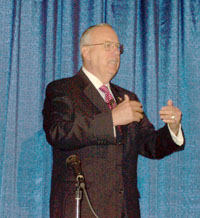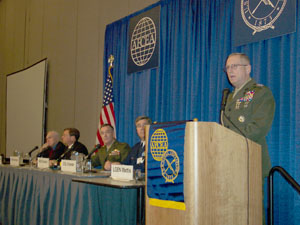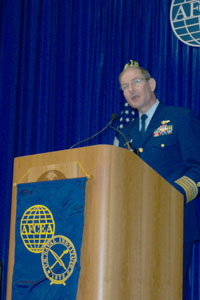Tuesday, January 10, 2006
Quote of the Day:
“When you face an enemy that regards death as a promotion, it is different.”
—Lt. Col. Ralph Peters,
West 2006, the annual conference and exposition sponsored by AFCEA International and the U.S. Naval Institute, began with a day of vital speeches and panels and ended with bagpipes and a videoteleconference with U.S. Marines in
Among the many lessons still being learned is the effect the global war on terrorism is having on the soldiers, sailors, airmen and Marines. Appropriately, the day’s first speaker was Thomas F. Hall, assistant secretary of defense for reserve affairs. Hall noted that 45 percent of
 |
| Thomas F. Hall, assistant secretary of defense for reserve affairs, gives the kickoff address at West 2006. |
“The concept of weekend warriors is dead,” Hall declared. “We are transitioning to a strategic and operational Reserve.”
Accordingly, the Defense Department is changing the way the Guard and Reserve are treated. Instead of being mobilized for 18 months, the goal is to reduce that period to 12 months. The department also is trying to channel regular force benefits such as bonuses, health care and housing to Guard and Reserve personnel. For example, everyone who re-signs on for another stretch of duty in theater receives a $15,000 bonus.
Other challenges remain. It may take up to $25 billion to replace the equipment left in Iraq; to repair gear brought back to the United States; and to provide equipment for modularization, force generation and homeland defense.
However, Hall is heartened by the support being provided to Guard and Reserve personnel by
Hall took the opportunity to dash a couple of popular misconceptions. A total of 500,000 Guard and Reserve members have been called up since the September 11, 2001, attacks, but their presence is shrinking, not growing. A year ago, 185,000 Guard and Reserve members were on active duty, but now only 130,000—116,000 in the Army—are mobilized.
And, the Army, Guard and Reserve all recently exceeded their recruiting goals. More people are staying on active duty despite—or because of—the wartime deployment.
Saying that journalist Tom Brokaw was right in labeling the Depression/World War II generation “the greatest generation,” Hall declared that, “Today we’re building the next-greatest generation.”
Immediately following Hall’s address was the day’s first panel discussion, which focused on warfighters’ lessons learned. Some panelists expanded on Hall’s comments, while others focused on new issues.
Moderating this panel was Lt. Gen. James N. Mattis, USMC, commanding general, Marine Corps Combat Development Command. Last year at West 2005, Gen. Mattis made remarks based on his combat experiences in
This year, few would argue with his point that the military must undergo significant changes to deal with the enemy in the global war on terror. War is a human problem, he stated, and the
 |
| Panelists discussing warfighters’ lessons learned from combat are (r to l) panel moderator Lt. Gen. James N. Mattis, USMC; Col. Gary L. Crowder, USAF; Brig. Gen. Joe Dunford, USMC; Rear Adm. Charles W. Martoglio, USN; and Maj. Gen. Robert Scales, USA (Ret.). |
Maj. Gen. Robert Scales,
As far as the Navy is concerned, the global war on terror is always running in the background—sometimes in the foreground, according to Rear Adm. Charles W. Martoglio, USN, director of Strategy and Policy Division (N5SP). Conventional campaigns are still out there, but the enemy is practicing unrestricted warfare—such as using children as human shields—that the United States will not do to them. And, weapons of mass destruction offer to generate a strategic-level effect with only a small number of people implementing their use.
The
But, when it comes to lessons learned, much of what the military has learned is basically what it knew before, declared Brig. Gen. Joe Dunford, USMC, director of Operations Division, Plans, Policy and Operations,
The U.S. Coast Guard is involved in both the Iraq War and in homeland security, and Vice Adm. Harvey E. Johnson, USCG, gave luncheon attendees an outline of its efforts and its close cooperation with the U.S. Navy. Adm. Johnson, commander, Coast Guard Pacific Area Command, explained how the Coast Guard has huge responsibilities, including that of dealing with maritime Pacific threats, but it does not have all of the necessary resources to meet these challenges.
 |
| Vice Adm. Harvey E. Johnson, USCG, commander, Coast Guard Pacific Area Command, gives Tuesday’s luncheon address at West 2006. |
The Coast Guard must balance homeland security with commerce. Domestically, 14 million shipping containers are handled annually in the
Adm. Johnson allowed as to how he is pleased with the relationship between the commander, U.S. Navy Third Fleet, and U.S. Coast Guard Pacific. This cooperation has been improving, and now both services can take steps to “rethink and redefine the relationship” between the Coast Guard and the Navy.
“The timing is right to ensure interoperability between [Coast Guard] Deepwater assets and Navy ships,” Adm. Johnson declared.
For many attendees, the highlight of the day’s events came in the evening. One of the Copernicus Award winners, Sgt. Matthew Eunice, USMC, was unable to attend the dinner in their honor because he was serving with his regimental combat team in
—Scheduled for Wednesday at West 2006: Speeches by the deputy commander of the




Comments